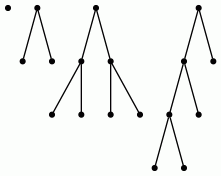
Binary tree shapes
module Sets.Recursive where open import Sets.Enumerated using (Bool; true; false)
The effect of this open import declaration is the same as if we copied the definition of Bool type here. Note that we enumerated the constructors of Bool too.
More about import declarations come later.
We are looking for a representation natural numbers. The simplest choice is the Peano representation which corresponds to the unary numeral system:
| term | interpretation in decimal form |
|---|---|
zero |
0 |
suc zero |
1 |
suc (suc zero) |
2 |
suc (suc (suc zero)) |
3 |
| ... | ... |
ℕIn Agda the definition
data ℕ : Set where zero : ℕ suc : ℕ → ℕ
yields the infinite set of judgements
ℕ : Set
zero : ℕ
suc zero : ℕ
suc (suc zero) : ℕ
suc (suc (suc zero)) : ℕ
...With the Emacs command C-c C-d one can get Agda to type-check a given expression (d stands for 'deduce').
Example: Hit C-c C-d and enter suc (suc zero).
Exercise: Try to type-check the following expressions:
suc zerosuc (zero)(suc) zerozero suc(suc suc) zerosucℕdata ℕ⁺ : Set where one : ℕ⁺ double : ℕ⁺ → ℕ⁺ double+1 : ℕ⁺ → ℕ⁺
yields (without ordering)
ℕ⁺ : Set
one : ℕ⁺
double one : ℕ⁺
double+1 one : ℕ⁺
double (double one) : ℕ⁺
double+1 (double one) : ℕ⁺
double (double+1 one) : ℕ⁺
double+1 (double+1 one) : ℕ⁺
double (double (double one)) : ℕ⁺
...And
data ℕ₂ : Set where zero : ℕ₂ id : ℕ⁺ → ℕ₂
yields
ℕ₂ : Set
zero : ℕ₂
id one : ℕ₂
id (double one) : ℕ₂
id (double+1 one) : ℕ₂
id (double (double one)) : ℕ₂
id (double+1 (double one)) : ℕ₂
...Soon we will prove in Agda that ℕ and ℕ₂ are isomorphic with the following relation:
| ℕ | ℕ₂ |
|---|---|
zero |
zero |
suc zero |
id one |
suc (suc zero) |
id (double one) |
suc (suc (suc zero)) |
id (double+1 one) |
| ... | ... |
Exercise: How 9 is represented in ℕ₂? Type-check the expression!
Question: why didn't we use one data definition with 4 constructors zero, one, double, double+1?
Each representation has its merit.
Exercise: Guess which representation (ℕ or ℕ₂) is better for the following tasks!
n * 2.⌊n / 2⌋.n + m.n * m.n + m = m + n for all m and n.A good strategy is to choose the right representation for each task and convert values between different representations.
ℤ!(Several solutions are possible.)
data BinTree : Set where leaf : BinTree node : BinTree → BinTree → BinTree
yields
BinTree : Set
leaf : BinTree
node leaf leaf : BinTree
node (node leaf leaf) leaf : BinTree
node leaf (node leaf leaf) : BinTree
node (node leaf leaf) (node leaf leaf) : BinTree
...BinTree elements are good for representing binary trees (just the shapes without data).
Exercise: define binary trees according to the following shapes!

Binary tree shapes